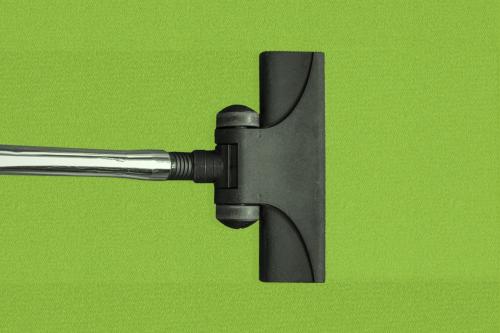
Table of Contents
- Best Commercial Vacuum
- Different Types of Commercial Vacuum Cleaners?
- Upright vs. Backpack Commercial Vacuums Compared
- Canister, Wet-Dry & Cordless Vacuums Explained
- Bagged vs. Bagless: What’s Better for Your Facility?
- Which Commercial Vacuum Is Best for Your Industry?
- FAQs: Choosing the Right Commercial Vacuum
- Making the Smart Vacuum Investment
Best Commercial Vacuum
In the fast-paced world of commercial cleaning, the right tools can make all the difference. From janitorial teams managing hotel floors to facility managers maintaining industrial warehouses, a high-performing vacuum cleaner is essential. And here's where most businesses fall into a trap: they assume all commercial cleaning devices do the same job.
But here's the truth: Not all vacuums are built equal.
Choosing from the types of commercial vacuums available today can optimize labor, increase productivity, and lower long-term maintenance costs. In this guide, we'll explore the types of commercial vacuum cleaners, uncover the pros and cons of each, and match them to their best use cases. Whether you're looking for upright commercial vacuums, wet-dry vacuums, or trying to decide between bagged vs. bagless models, this blog has the answers you need. Let's vacuum up the confusion.
Step-by-Step Guide: Choosing the Right Commercial Vacuum
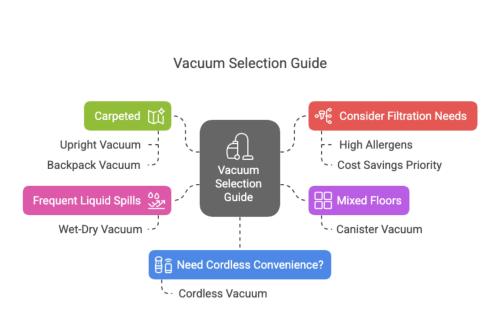
Selecting the right commercial vacuum cleaner is essential for maintaining cleanliness, boosting productivity, and cutting long-term costs. The wrong choice can lead to wasted time, higher expenses, and poor cleaning results. To help you make the best decision, follow this step-by-step guide to find the perfect vacuum for your business needs.
- Identify Cleaning Surfaces: Carpet, tile, hardwood, concrete?
- Determine Cleaning Frequency: Daily, weekly, or ad hoc?
- Consider Facility Type: Office, hotel, school, warehouse, etc.
- Account for User Ergonomics: How many people will operate the vacuum?
- Prioritize Filtration Needs: Does your space require HEPA filters?
- Evaluate Portability Requirements: Do you need cordless or backpack units?
- Set a Budget: Consider initial cost and long-term maintenance.
Use this checklist to narrow your options.
Different Types of Commercial Vacuum Cleaners?
Each commercial vacuum cleaner is engineered for specific scenarios. Below are the main types of commercial vacuums and their best use cases:
- Upright Vacuums: Best for wide, carpeted areas like hotel hallways and lobbies.
- Backpack Vacuums: Lightweight, portable, ideal for cleaning staircases or tight spaces.
- Canister Vacuums: Feature powerful suction and maneuverability, perfect for various flooring types.
- Wet-Dry Vacuums: Excellent for industrial use where both solid debris and liquid spills are common.
- Cordless Vacuums: Battery-powered for convenience, great for small businesses and quick jobs.
- Bagged and Bagless Models: Refer to waste collection methods and filtration efficiency.
| Vacuum Type | Best For | Pros | Cons |
|---|---|---|---|
| Upright | Hotels, offices, schools | Wide path, deep clean, user-friendly | Bulky, hard to use in corners |
| Backpack | Staircases, tight spaces, multi-floor | Lightweight, portable, efficient | Training needed, not for open areas |
| Canister | Mixed floor types, quiet zones | Strong suction, maneuverable | Awkward on stairs |
| Wet-Dry | Warehouses, auto shops, construction | Handles solids/liquids, high capacity | Loud, not for routine cleaning |
| Cordless | Retail, salons, small offices | No cord hassle, flexible | Limited battery, less power |
Upright vs. Backpack Commercial Vacuums Compared

When comparing upright vs. backpack commercial cleaning equipment, it's essential to consider factors like cleaning costs, labour efficiency, and ease of use in real-world commercial applications. In both the United States and Canada, upright vacuum cleaners are favoured for wide, open areas with heavy carpet, offering durable design and a lower cost of ownership.
Meanwhile, backpack vacuums are ideal for janitorial staff who need to reach areas around fixtures or clean multiple floors efficiently, often resulting in reduced total cleaning costs. Whether you're tackling hard floors, dry vacuum cleaner jobs, or spaces with tight corners—where a crevice tool comes in handy—the right machine enhances productivity and performance.
Efficiency in cleaning operations is paramount. The AICS time and motion study on industrial vacuum cleaners reveals that backpack vacuums can significantly reduce cleaning time in large facilities compared to traditional upright models.
Upright Commercial Vacuums
Pros:
- Powerful suction, especially on carpets
- Familiar design and easy to operate
- Built-in brush rolls for deep cleaning
Cons:
- Heavier and bulkier
- Less ideal for tight corners or under furniture
Best Use: Hotels, schools, and office hallways where carpet coverage is extensive.
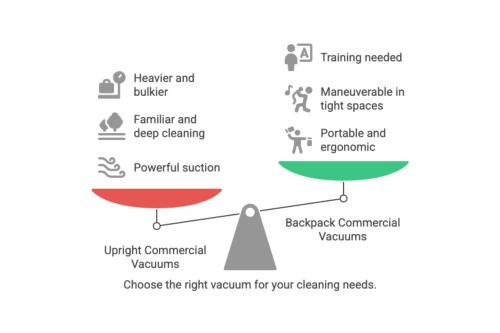
Backpack Commercial Vacuums
Pros:
- Ultra-portable and ergonomic
- Easy to maneuver in tight spaces and on stairs
- Lightweight, reducing user fatigue
Cons:
- Requires training for optimal use
- May not be ideal for large open areas
Best Use: Cleaning crews covering multiple floors or navigating around furniture and obstacles.
Canister, Wet-Dry & Cordless Vacuums Explained
Among the various types of commercial vacuums, canister, wet-dry, and cordless models stand out for their specialized performance. Canister vacuums offer powerful suction and maneuverability, making them ideal for multi-surface cleaning in offices and schools. Wet-dry vacuums are built for heavy-duty jobs, effortlessly handling both liquid spills and solid debris in industrial and warehouse environments. Meanwhile, cordless vacuums provide unmatched flexibility, perfect for spot cleaning in retail spaces or hard-to-reach areas. Choosing the right type from these ensures efficient cleaning tailored to your facility’s unique demands.

Canister Vacuums
These models offer a great balance of power and flexibility.
Pros:
- High suction power
- Excellent for mixed floor types
- Quieter operation
Cons:
- Can be cumbersome to move on stairs
Best Use: Healthcare facilities, offices, and educational institutions.
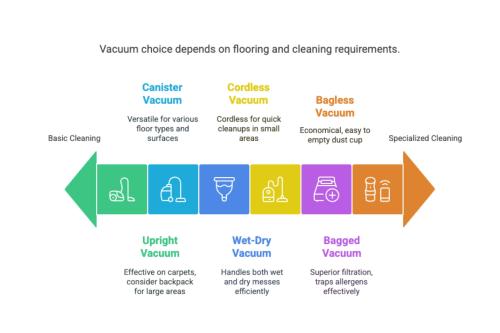
Wet-Dry Commercial Vacuums
The workhorses of industrial environments.
Pros:
- Handles both solid and liquid messes
- Large tanks reduce need for frequent emptying
- Rugged design for heavy-duty tasks
Cons:
- Bulky and loud
- Overkill for routine cleaning tasks
Best Use: Warehouses, workshops, and auto garages.
Cordless Commercial Vacuums
Freedom from the cord, with a trade-off in runtime.
Pros:
- No cord restrictions
- Lightweight and easy to store
Cons:
- Limited battery life
- Not as powerful as corded models
Best Use: Spot cleaning in retail stores, salons, or quick touch-ups in busy environments.
Bagged vs. Bagless: What’s Better for Your Facility?

When deciding between bagged and bagless vacuums for your facility, it ultimately depends on your needs, such as filtration, maintenance, and cost. Bagged models are often preferred for their better filtration, while bagless models can save on long-term costs by eliminating the need for replacement bags.
Bagged Vacuums
Pros:
- Better filtration (especially for allergens)
- Hygienic waste disposal
- Ideal for sensitive environments
Cons:
- Ongoing cost of replacement bags
- Decreased suction as the bag fills
Best Use: Hospitals, clinics, and senior care centres.
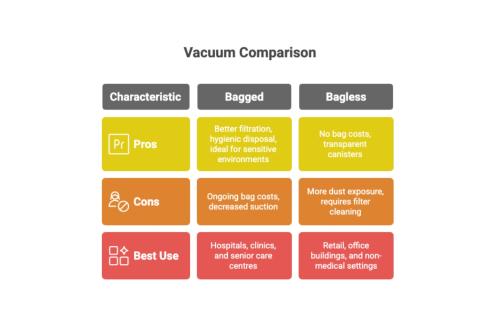
Bagless Vacuums
Pros:
- No ongoing bag costs
- Transparent canisters make it easy to see when to empty
Cons:
- More dust exposure during disposal
- Requires regular filter cleaning
Best Use: Retail, office buildings, and non-medical settings.
Which Commercial Vacuum Is Best for Your Industry?
Consulting a comprehensive directory of industrial vacuum cleaner manufacturers is a strategic starting point for businesses seeking specialized heavy-duty cleaning equipment. These directories often include detailed product specifications, certifications, and manufacturer insights that can help you compare options more effectively.
When selecting an industrial cleaning solution, it’s crucial to align the machine’s capabilities with the specific demands of your work environment. Considerations like flooring type—such as concrete, tile, or carpet—the average volume of debris, and whether the space requires HEPA filtration or wet-dry functionality all play a significant role. For instance, warehouses may need high-capacity wet-dry vacuums with rugged construction, while healthcare facilities benefit from models with advanced filtration and quiet operation. Identifying these requirements ensures that it can deliver optimal performance for your business.
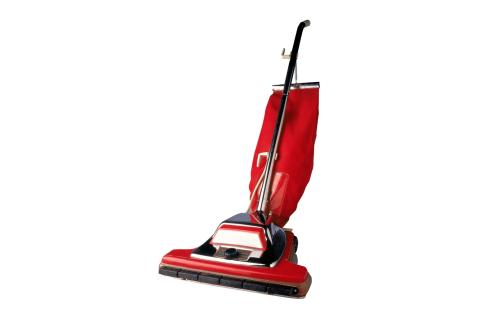
Best Vacuums for Hotels, Offices & Schools
- Upright vacuums for quick coverage of carpeted floors
- Canister vacuums for flexibility across multiple surface types
- Backpack vacuums to reduce fatigue during long cleaning shifts
Key features to look for:
- Quiet operation (especially in hotels)
- HEPA filters for dust and allergen control
- Lightweight designs for mobility
Best Vacuums for Warehouses & Industrial Settings
- Wet-dry vacuums for handling spills and debris
- Cordless vacuums for hard-to-reach or outdoor areas
- Heavy-duty canister vacuums for power and tank capacity
Considerations:
- Durability and tank size
- Suction power
- Accessory variety for handling diverse mess types
Commercial Vacuum Maintenance Tips
- Replace filters regularly (HEPA every 6-12 months).
- Empty bags/canisters before they’re 80% full.
- Clean brush rolls weekly to prevent clogs.
- Inspect cords and hoses monthly for damage.
- Charge cordless batteries only when needed to preserve lifespan.
- Schedule annual service checks for high-usage environments
FAQs: Choosing the Right Commercial Vacuum

What type of commercial vacuum is best for large carpeted areas?
Upright vacuums are the top choice thanks to their wide cleaning path and deep-cleaning brush rolls.
Are backpack vacuums more ergonomic than upright models?
Yes, especially for cleaning stairs or large buildings, as they distribute weight evenly and reduce back strain.
Can you use a commercial vacuum at home?
Absolutely. Many homeowners prefer industrial cleaning equipment for its durability and power.
Is bagged or bagless better for allergy sufferers?
Bagged vacuums are generally better, as they trap allergens more effectively and offer hygienic disposal.
How do I choose the right vacuum for my industry?
Consider your floor types, space constraints, and cleaning frequency. Use our step-by-step guide to match floor type,cleaning frequency, and ergonomics with the right machine. Our guide helps match vacuums by setting and need.
Making the Smart Vacuum Investment
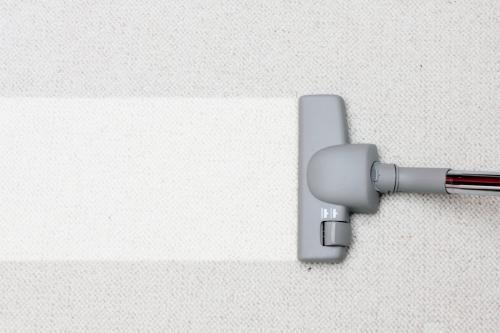
Industrial cleaning solutions aren't one-size-fits-all. The best heavy-duty cleaning equipment for your business depends on your industry, space layout, surface types, and cleaning frequency. From upright models that power through carpets to wet-dry cleaning tools tough enough for industrial messes, the right cleaner saves you time, money, and energy.
Now that you're equipped with the knowledge of types of commercial vacuum cleaners, their pros, cons, and ideal use cases, you're ready to make an informed decision.
Whether you're managing a boutique hotel or a 100,000 sq ft warehouse, the right industrial cleaning equipment makes all the difference. Browse our curated list of top-rated machines today, or speak to a specialist to match the model to your cleaning needs.
Next steps? Explore our online catalogue of top-rated professional cleaning machines or talk to a product expert for a tailored recommendation.
Clean smarter, not harder.

